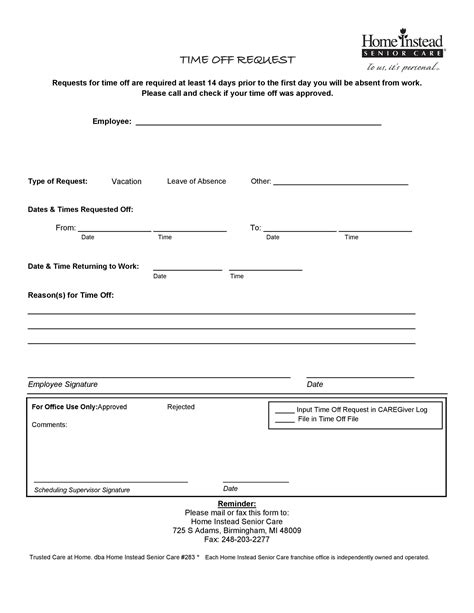Requesting And Securing Time Off From Work: A Step-By-Step Guide

Do you need time off from work but don’t know how to ask for it? Whether it’s for a vacation, personal or family matter, or simply to recharge your batteries, taking time off from work is important for your mental and physical health. However, requesting and securing time off from work can be a daunting task, especially if you’re not sure about the company’s policies and procedures. That’s why we’ve put together this comprehensive step-by-step guide to help you navigate the process smoothly and confidently.
Step 1: Check Your Company’s Policy
The first step in requesting time off from work is to check your company’s policy. This will help you understand the rules and regulations around taking time off and ensure that you follow the correct procedures. Some companies require employees to give notice a certain amount of time in advance, while others have blackout periods during certain times of the year. Make sure to read the policy carefully and note any specific requirements or restrictions.
Example:
If you work for XYZ Corporation, you can find the company’s policy on time off in the employee handbook, which is available on the company’s intranet.
Step 2: Choose the Right Time
Once you’ve reviewed your company’s policy, choose the right time to request time off. This means considering your workload, upcoming projects, and deadlines, as well as the needs of the company and your colleagues. It’s important to be strategic and plan ahead so that your absence doesn’t disrupt the workflow or cause unnecessary stress for your team.
Example:
If you work in the accounting department, it might be best to avoid requesting time off during tax season when the workload is particularly heavy.
Step 3: Plan Your Request
Before making your request, plan what you’re going to say and how you’re going to say it. This includes choosing the right time and place to make your request, as well as preparing any necessary paperwork or documentation. Be clear and concise about your reasons for taking time off and how it will benefit both you and the company.
Example:
If you’re requesting time off to attend a family wedding, you might say: “I would like to request time off from work from June 1st to June 5th to attend my sister’s wedding. I understand that this is during a busy time for the company, but I have completed all my current projects and have arranged for a colleague to cover my responsibilities while I’m away.”
Step 4: Submit Your Request
Once you’ve planned your request, it’s time to submit it. This may involve filling out a form, speaking to your manager or HR representative, or sending an email. Make sure to follow the correct procedures outlined in your company’s policy and provide any necessary documentation.
Example:
If your company requires you to fill out a form, you can download it from the HR section of the company’s intranet and submit it to your manager for approval.
Step 5: Follow Up
After submitting your request, follow up with your manager or HR representative to ensure that it has been received and is being processed. This will help you avoid any miscommunication or confusion and ensure that your request is approved in a timely manner. If your request is denied, ask for feedback on why it was denied and if there are any alternative options.
Example:
You might follow up with an email that says: “I wanted to check in and see if my request for time off has been received and if there are any updates on its status. Please let me know if you need any additional information from me.”
Step 6: Enjoy Your Time Off
Once your request has been approved, it’s time to enjoy your time off! Make sure to plan ahead and prepare for your absence so that you can fully disconnect and recharge. This may involve delegating tasks to your colleagues, setting up an out-of-office message, or completing any necessary work before you leave.
Example:
If you’re going on a vacation, make sure to book your accommodations and transportation in advance, create an itinerary, and inform your family and friends of your plans.
Conclusion
Requesting and securing time off from work can seem overwhelming, but by following these six steps, you can navigate the process confidently and successfully. Remember to check your company’s policy, choose the right time, plan your request, submit it correctly, follow up, and enjoy your time off!
FAQs
Q: How much notice do I need to give for time off?
A: This varies by company and is typically outlined in the company’s policy. Some companies require employees to give notice a certain amount of time in advance, while others have more flexible policies. Make sure to review your company’s policy and follow the guidelines accordingly.
Q: Can my employer deny my request for time off?
A: Yes, your employer can deny your request for time off if it doesn’t align with the company’s policy or if it would cause undue hardship on the company or your colleagues. However, your employer should provide feedback on why the request was denied and if there are any alternative options.
Q: Can I take time off without pay?
A: This depends on your company’s policy and your employment agreement. Some companies allow employees to take time off without pay, while others do not. Make sure to review your company’s policy and speak to your manager or HR representative if you have any questions.
Q: Do I need to provide documentation for my time off request?
A: This depends on your company’s policy and the reason for your time off. Some companies require employees to provide documentation, such as a doctor’s note for medical leave or a wedding invitation for personal leave. Make sure to review your company’s policy and provide any necessary documentation with your request.
